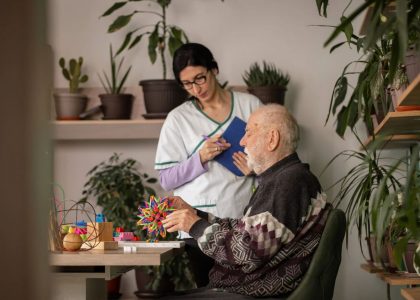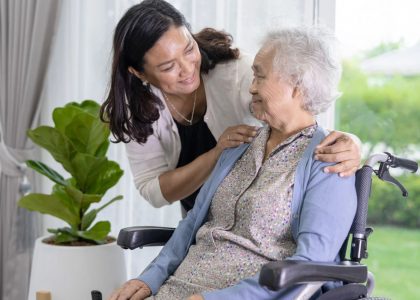Creating a Safe Haven for Dementia Patients: Essential Tips for Physical and Mental Well-being
Creating a secure and comfortable environment for individuals with dementia is crucial yet challenging due to the multitude of safety aspects involved. To help, we’ve compiled essential tips to ensure physical and mental safety in various scenarios, making the process more manageable.
Safety modifications of the home.
When addressing the safety of individuals with dementia, especially those dealing with heightened risks of falls, prioritising home modifications becomes crucial.
Handrails strategically placed in areas where stability might be compromised offer essential support. These rails can provide reassurance and aid in balance, especially in spaces like hallways or bathrooms where unsteadiness might occur.
Installing grab bars, particularly near toilets or showers, ensures individuals can maintain stability for longer periods, reducing the likelihood of slips or falls in potentially hazardous areas.
Ramps are another key modification, particularly for areas with steps. These provide a safer alternative for those who may struggle with stairs, minimizing the risk of accidents.
Moreover, addressing the risk of wandering for individuals with dementia is just as important. Implementing preventive measures such as locks or alarms, especially on doors leading outside, can help disperse the danger of wandering. Assessing their living space to identify potential exit points and making them more secure can significantly reduce the risk.
By proactively implementing these safety procedures and modifications within the home, the potential for accidents, injuries, and wandering can be significantly reduced, creating a safer and more secure home for elderly individuals, especially those dealing with the challenges of dementia and medication-related vulnerabilities.

Simplify their space.
Simplifying the living space of individuals with dementia offers numerous benefits that go beyond just organization. By decluttering and organizing their environment, it minimizes potential hazards and promotes a sense of calmness and security.
Removing unnecessary items and hazards like loose wires or furniture obstacles, reduces the risk of accidents like tripping or knocking things over. A clear, open space allows for easier navigation, promoting mobility and independence for individuals with dementia.
Moreover, a simplified space contributes to a more relaxing atmosphere, essential for promoting relaxation and reducing anxiety. A clutter-free environment minimizes sensory overload, allowing individuals to focus better and feel more grounded during challenging moments. After all, there is the saying ‘clear space, clear mind’!
Labelling cabinets and drawers where contents are concealed is another great implementation. It alleviates the stress and frustration of not being able to locate essential items, which can often be an overwhelming experience for someone with dementia. Clearly labelled storage spaces help them to easily identify and access what they need, allowing a sense of independence and confidence in their daily routines.
These labels also serve as memory aids, reinforcing the association between objects and their designated storage areas. This in turn helps with memory retention, helping individuals remember where things are kept and reducing confusion or disorientation.

Give them familiar settings.
Whether in a care home or in their own house, keeping a familiar setting is crucial to providing a safe space for someone suffering from dementia. It’s been factually shown that having a recognisable surrounding can alleviate stress and anxiety for sufferers, especially during times of distress.
Objects such as pictures of their loved ones, cherished belongings from home and familiar objects are all great instruments of keeping grounded and feeling at home in your own mind. Maintaining familiarity vital in caring for individuals with dementia, whether at home or in a care facility. Studies consistently highlight the positive impact of recognizable surroundings in reducing stress and anxiety, particularly during moments of confusion or distress.
By incorporating personal items like family photographs, cherished belongings, and familiar objects into their living space, individuals with dementia can feel more grounded and at ease. These items serve as connections to their memories, providing a sense of continuity and comfort.
Creating spaces reminiscent of their previous home or incorporating familiar decor helps create a sense of safety and belonging. Whether it’s arranging furniture similarly or using familiar colours and patterns, these elements trigger positive memories and reinforce a feeling of being in a secure and familiar environment.
In care homes, personalized spaces within communal areas offer residents a sense of individuality. Tailoring these spaces with familiar objects fosters a comforting atmosphere and a sense of belonging, even in shared environments.
Overall, prioritizing familiar settings enriched with meaningful personal items plays a crucial role in providing stability and comfort for individuals navigating the challenges of dementia. These familiar elements act as anchors, helping individuals keep a sense of identity and security within their surroundings.

Keeping consistency
Establishing consistent daily routines is a powerful tool in supporting individuals coping with dementia. These routines create a structured framework that provides a sense of predictability, which can significantly reduce stress and uncertainty.
Routine acts as a reliable guide throughout the day, offering a familiar sequence of activities and events. This predictability helps individuals feel grounded and more at ease, especially when faced with memory-related challenges.
Having set times for meals and maintaining a regular sleep schedule are key components of these routines. Mealtimes provide not only nourishment but also a comforting rhythm to the day, while a consistent sleep pattern promotes better rest and overall well-being.

Ease of access to healthcare.
It’s no secret that while caring for someone with dementia you need to be familiar with the ins and outs of healthcare regarding them but also need to have easy access to the recourses, whether it’s the chemist for any medication mix-ups, the GP for any health scares, or the emergency services or wandering response team for anyone who wanders off. Knowing the procedures and ins and outs of these will mean a streamline and less stressful time if a situation occurs that warrants reaching out.

All these aspects would aid in creating a stress-free environment for someone you care for. By maintaining a tidy, calming space, attending to their physical needs, and offering emotional support, you can help create an environment where they feel safe, understood, and cared for. Encouraging social interactions and activities they enjoy fosters a sense of belonging and contentment. Ultimately, tailoring your approach to their individual needs and preferences forms the foundation for a nurturing and stress-free environment where they can thrive.
Looking for more ways to create the best environment for elderly people? Look at our past post about the mental health of seniors here!






